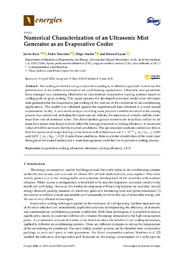Por favor, use este identificador para citar o enlazar este ítem:
https://hdl.handle.net/11000/35363Registro completo de metadatos
| Campo DC | Valor | Lengua/Idioma |
|---|---|---|
| dc.contributor.author | Ruiz Ramírez, Javier | - |
| dc.contributor.author | Martínez, Pedro | - |
| dc.contributor.author | Martín, Iñigo | - |
| dc.contributor.author | Lucas Miralles, Manuel | - |
| dc.contributor.other | Departamentos de la UMH::Ingeniería Mecánica y Energía | es_ES |
| dc.date.accessioned | 2025-01-28T09:08:20Z | - |
| dc.date.available | 2025-01-28T09:08:20Z | - |
| dc.date.created | 2020 | - |
| dc.identifier.citation | Energies | es_ES |
| dc.identifier.issn | 1996-1073 | - |
| dc.identifier.uri | https://hdl.handle.net/11000/35363 | - |
| dc.description.abstract | Pre-cooling of inlet air using evaporative cooling is an effective approach to enhance the performance of air-cooled condensers in air conditioning applications. Ultrasonic mist generators have emerged as a promising alternative to conventional evaporative cooling systems based on cooling pads or spray cooling. This paper presents the developed numerical model of an ultrasonic mist generator for the evaporative pre-cooling of the inlet air of the condenser in air conditioning applications. The model was validated against the experimental data obtained in a wind tunnel experimental facility. A parametric analysis including some physical variables involved in the cooling process was carried out, including the main axial air velocity, the injection air velocity and the water mass flow rate of atomized water. The dimensionless groups water-to-air mass flow and air-to-air mass flow ratios were found to most affect the average evaporative cooling efficiency. A maximum value of 0.654 was found for the studied conditions. The optimization analysis carried out shows that the operational ranges leading to the best overall performance are 5×10−4≤𝑚˙𝑤/𝑚˙𝑎𝑇≤0.002 and 0.035≤𝑚˙𝑎𝑖/𝑚˙𝑎𝑇≤0.05 . Under these conditions, there is a better distribution of the water mist throughout the control section and a more homogeneous and effective evaporative cooling process. | es_ES |
| dc.format | application/pdf | es_ES |
| dc.format.extent | 20 | es_ES |
| dc.language.iso | eng | es_ES |
| dc.publisher | MDPI | es_ES |
| dc.relation.ispartofseries | 13 | es_ES |
| dc.relation.ispartofseries | 11 | es_ES |
| dc.rights | info:eu-repo/semantics/openAccess | es_ES |
| dc.rights.uri | http://creativecommons.org/licenses/by-nc-nd/4.0/ | * |
| dc.subject | evaporative cooling | es_ES |
| dc.subject | ultrasonic nebulizer | es_ES |
| dc.subject | cooling efficiency | es_ES |
| dc.subject | CFD | es_ES |
| dc.subject.other | CDU::6 - Ciencias aplicadas::62 - Ingeniería. Tecnología::621 - Ingeniería mecánica en general. Tecnología nuclear. Electrotecnia. Maquinaria | es_ES |
| dc.title | Numerical Characterization of an Ultrasonic Mist Generator as an Evaporative Cooler | es_ES |
| dc.type | info:eu-repo/semantics/article | es_ES |
| dc.relation.publisherversion | https://doi.org/10.3390/en13112971 | es_ES |

View/Open:
2020 energies-13-02971-v2 (1).pdf
6,02 MB
Adobe PDF
Share:
.png)
